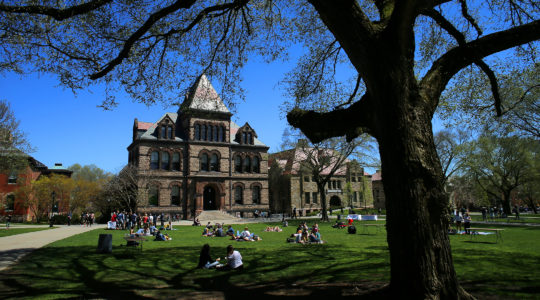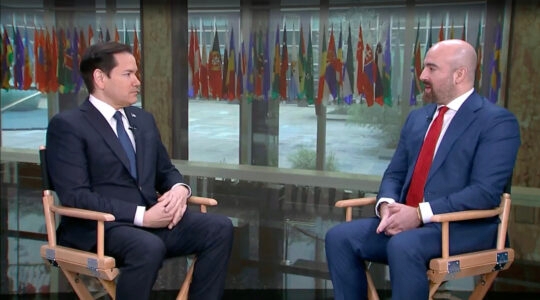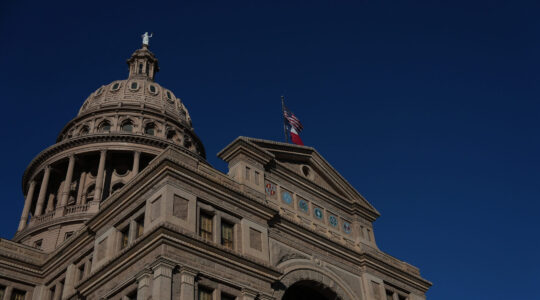BEHIND THE HEADLINES
NEW YORK (JTA) — A few days after last week’s shooting at the U.S. Holocaust Memorial Museum in Washington, the interim director of the Kansas City Jewish Community Center had to reassure the parent of an incoming preschool student that she would do everything possible to make sure the woman’s child would be safe at a Jewish school.
“She said she is freaked out by the news,” the director, Jill Maidhoff, told JTA.
For some Americans working at Jewish institutions, the Washington shooting — on the heels of a foiled bombing plot at two New York synagogues and the shooting at a Connecticut bookstore near Wesleyan College by an assailant claiming to have targeted Jews — has underscored the wisdom of the Jewish community’s nearly decade-long effort, since the 9/11 attacks, to make its institutions more secure.
But for many, the question isn’t necessarily what more can be done in terms of security, but how to balance security needs with the imperative to make Jewish institutions open and inviting.
“It is a constant balance effort to strike between appearing to be a very permeable building and a safe building,” Maidhoff said.
The Hillel chapter at the University of Wisconsin at Madison was faced with the same challenge when it designed a new building, which is expected to open soon.
Unlike Jewish institutions that have roadblocks and physical barriers that make the entrance look like an Israeli Embassy, the Wisconsin Hillel opted for security cameras and doors that could be locked quickly and turned into entranceways that require permission to enter, executive director Greg Steinberger said.
Hillel was in constant dialogue with its contractors throughout the building process about how to create an open yet secure space.
“On a college campus you want to be open and limit barriers, but you need to be prepared for when you need those barriers,” Steinberger said.
Since the attacks of Sept. 11, 2001, millions of dollars — much of it from the U.S. Department of Homeland Security — have been spent to upgrade security at Jewish schools, synagogues, museums, camps, JCCs and other institutions. Now, many institutional officials say, they are doing the maximum possible to protect their clients.
In 2004, the Secure Community Network was created to help with security and train employees at Jewish institutions on how to keep their places of work safe and their eyes open for abnormal activity. Institutions have developed emergency plans in the event of an attack. Security cameras have been installed, and some buildings have erected concrete barriers and hired armed guards.
The day after the Washington shooting on June 10, the Secure Community Network — an initiative of the Jewish Federations of North America and the Conference of Presidents of Major American Jewish Organizations — held an online seminar on security for more than 300 synagogues and Jewish institutions.
“My message has been that we have to remain vigilant forever,” said the network’s executive director, Paul Goldenberg. But, he added, “That does not mean building walls around our communities or fences around our communities and our children.”
At the 12 camps run by the Union for Reform Judaism, security has meant fences. The camps underwent a security overhaul after 9/11, according to URJ’s director of camping and Israel programs, Paul Reichenbach.
The URJ hired an Israeli security company to survey its camps and make recommendations on how to secure their boundaries. Suggestions ranged from installing electrified front gates to more lighting. The URJ wrote a security manual and for the first time insisted that its camps have someone — a camp official or security guard — awake all night to ensure that all is well. It also pays for Israeli security guards.
“We want to send a message that you need permission to enter,” Reichenbach said.
After the museum shooting, word spread to Jewish institutions through a network of formal and informal communication from Jewish federations and law enforcement that a place of Jewish interest had experienced a violent attack.
The Westchester Jewish Conference in suburban New York sent an e-mail alert that day to more than 130 organizations offering tips on how to be more vigilant.
“No Jewish institution has woken up in the past two months and said, ‘Whoa, we need more security,’” said Elliot Forchheimer, executive director of the Westchester organization. “Enormous money has been allocated to security. We meet quarterly with all of the organizations in Westchester to discuss what are you doing and how can you get grant money and are you paying for guards and how do you use them, do they carry guns or not.”
Fuel for Truth, an Israel advocacy organization, at an event for some 400 guests the day after the museum shooting had everyone go through metal detectors and inspection by beefy security guards before they could enter the Manhattan nightclub.
Executive director Joe Richards said any gathering of the group that consists of more than 10 people, even a board meeting, requires a security plan.
“We don’t mess around,” Richards told JTA. “You can’t just rely on external security. Pre-World War II, Jews relied on governments to protect them. You have to take it into your own hands, not just be more vigilant.”
JTA has documented Jewish history in real-time for over a century. Keep our journalism strong by joining us in supporting independent, award-winning reporting.





